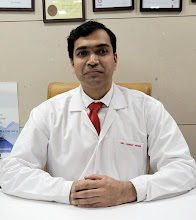Age-Related Macular Degeneration (AMD) is an eye condition that affects the macula, which is the central part of the retina responsible for sharp, detailed vision. It is the leading cause of severe vision loss and blindness among people over the age of 50. AMD primarily occurs in older adults, hence the term "age-related."
Types of AMD:
Dry AMD: Dry AMD is the more common form, accounting for about 85-90% of cases. It develops when the macula thins and small clumps of protein called drusen accumulate, gradually impairing central vision.
Wet AMD: Wet AMD is less common but more severe. It occurs when abnormal blood vessels grow beneath the macula, leaking blood and fluid, leading to rapid and significant vision loss.
Symptoms of AMD:
AMD may initially present with subtle or no symptoms. As the condition progresses, the following signs and symptoms may appear:
Blurred or distorted central vision: Straight lines may appear wavy or crooked, and objects may seem blurry or out of focus.
Dark or empty areas in central vision: You may experience a blind spot or a missing area in the center of your visual field.
Decreased color perception: Colors may appear faded or less vibrant.
Difficulty recognizing faces: Facial features may be hard to distinguish.
It is important to note that AMD does not cause total blindness, as peripheral (side) vision remains intact. However, it significantly impairs activities that require sharp central vision, such as reading, driving, and recognizing faces.
Treatment Options for AMD:
While there is no cure for AMD, several treatment options are available to manage the condition and slow its progression. The choice of treatment depends on the type and severity of AMD:
Dry AMD Treatment:
Nutritional supplements: Certain high-dose antioxidant vitamins and minerals, such as vitamins C and E, zinc, copper, and lutein/zeaxanthin, may help slow the progression of dry AMD in some individuals. However, these supplements should only be taken under the guidance of an eye care professional.
Lifestyle modifications: Adopting a healthy lifestyle can support eye health. This includes eating a balanced diet rich in green leafy vegetables, fish, and fruits, maintaining normal blood pressure and cholesterol levels, exercising regularly, avoiding smoking, and protecting the eyes from harmful UV rays.
Wet AMD Treatment:
Anti-VEGF injections: Currently, the most effective treatment for wet AMD is the use of anti-VEGF (vascular endothelial growth factor) medications, which are injected into the eye. These drugs block the abnormal blood vessel growth and help reduce fluid leakage, preserving and sometimes improving vision.
Photodynamic therapy: In some cases, photodynamic therapy may be used to treat wet AMD. It involves injecting a light-activated drug into a vein, which is then activated by a laser to destroy abnormal blood vessels.
Laser therapy: Laser treatment is less commonly used now but may still be considered in specific cases of wet AMD to target and seal leaking blood vessels.
Regular monitoring and follow-up visits with an eye care professional are crucial for assessing the progression of AMD and determining the appropriate treatment options.
It's important to note that early detection and intervention play a vital role in managing AMD. If you notice any changes in your vision or have concerns about AMD, consult an eye care specialist for a comprehensive eye examination and appropriate guidance.
Note: This information is provided for educational purposes and is not a substitute for professional medical advice. Always consult a qualified healthcare professional for diagnosis and treatment options tailored to your specific condition.

No comments:
Post a Comment